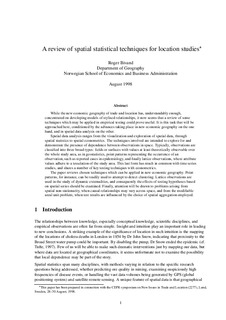A review of spatial statistical techniques for location studies
Research report
Permanent lenke
http://hdl.handle.net/11250/162352Utgivelsesdato
1998Metadata
Vis full innførselSamlinger
- Geografi i Bergen [35]
Sammendrag
While the new economic geography of trade and location has, understandably enough,
concentrated on developing models of stylised relationships, it now seems that a review of some
techniques which may be applied in empirical testing could prove useful. It is this task that will be
approached here, conditioned by the advances taking place in new economic geography on the one
hand, and in spatial data analysis on the other.
Spatial data analysis ranges from the visualization and exploration of spatial data, through
spatial statistics to spatial econometrics. The techniques involved are intended to explore for and
demonstrate the presence of dependence between observations in space. Typically, observations are
classified into three broad types: fields or surfaces with values at least theoretically observable over
the whole study area, as in geostatistics, point patterns representing the occurrence of an
observation, such as reported cases in epidemiology, and finally lattice observations, where attribute
values adhere to a tesselation of the study area. This last form has much in common with time series
studies, and shares a number of key testing techniques with econometrics.
The paper reviews chosen techniques which can be applied in new economic geography. Point
patterns, for instance, can be readily used to attempt to detect clustering. Lattice observations are
used in the study of dynamic externalities, and consequently the effects of testing hypotheses based
on spatial series should be examined. Finally, attention will be drawn to problems arising from
spatial non-stationarity, when causal relationships may vary across space, and from the modifiable
areal unit problem, when test results are influenced by the choice of spatial aggregation employed.
Utgiver
University of Bergen. Department of GeographySerie
Geografi i Bergen221
